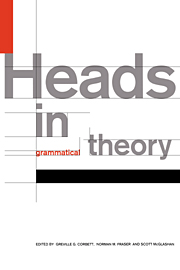Book contents
- Frontmatter
- Contents
- List of contributors
- 1 Introduction
- 2 The head of Russian numeral expressions
- 3 The phonology of heads in Haruai
- 4 Patterns of headedness
- 5 Head-hunting: on the trail of the nominal Janus
- 6 The headedness of noun phrases: slaying the nominal hydra
- 7 Head- versus dependent-marking: the case of the clause
- 8 Heads in discourse: structural versus functional centricity
- 9 Heads in Head-driven Phrase Structure Grammar
- 10 Heads and lexical semantics
- 11 Heads, parsing and word-order universals
- 12 Do we have heads in our minds?
- 13 Heads, bases and functors
- References
- Index
6 - The headedness of noun phrases: slaying the nominal hydra
Published online by Cambridge University Press: 23 February 2010
- Frontmatter
- Contents
- List of contributors
- 1 Introduction
- 2 The head of Russian numeral expressions
- 3 The phonology of heads in Haruai
- 4 Patterns of headedness
- 5 Head-hunting: on the trail of the nominal Janus
- 6 The headedness of noun phrases: slaying the nominal hydra
- 7 Head- versus dependent-marking: the case of the clause
- 8 Heads in discourse: structural versus functional centricity
- 9 Heads in Head-driven Phrase Structure Grammar
- 10 Heads and lexical semantics
- 11 Heads, parsing and word-order universals
- 12 Do we have heads in our minds?
- 13 Heads, bases and functors
- References
- Index
Summary
Introduction
How many heads does a noun phrase have? In the traditional generative conception, the answer is simple: the noun phrase has a single head which is a noun. We shall call this the single-head hypothesis. In the single-head hypothesis, other typical noun-phrase constituents (articles, demonstratives, quantifiers, numerals, adjective phrases, adpositional phrases, relative clauses, etc.) are all treated as modifiers of the head noun.
An alternative to the single-head hypothesis which has recently gained in popularity is the idea that the noun phrase contains at least one head, and possibly a multiplicity of heads, in addition to the noun. Each such head, typically but not necessarily a functional category such as a determiner, numeral or quantifier, has its own phrasal projection and takes another noun-phrase constituent as its complement. We shall call this the multi-head hypothesis.
Section 6.2 of this chapter provides a preliminary discussion of the single-head hypothesis (6.2.1) and the multi-head hypothesis (6.2.2). In section 6.3, which is the heart of the chapter, five specific arguments are then presented which lend support to the single-head hypothesis: incorporation (6.3.1), subcategorization (6.3.2), the position of possessor phrases (6.3.3), apposition (6.3.4) and agreement and government (6.3.5). In conclusion, section 6.4 lists the consequential syntactic and morphological properties which focus on the noun as the central constituent of the noun phrase.
Two hypotheses of noun-phrase structure
In this section, we present an initial comparison of the single-head and multi-head hypotheses.
- Type
- Chapter
- Information
- Heads in Grammatical Theory , pp. 114 - 139Publisher: Cambridge University PressPrint publication year: 1993
- 6
- Cited by



